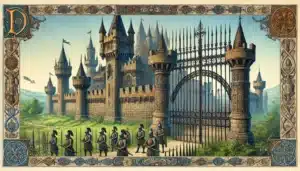At a Glance
- Understanding Your Needs
- Evaluating the Options Based on Needs
- Choosing the Right Material
- Budget Planning: Ensuring Value for Money
- Fence Planning FAQs
In the realm of home improvement and outdoor design, a fence is more than just a functional element—it’s an expression of your home’s personality and a testament to your aesthetic sensibility. Fences serve multiple purposes, from providing privacy and enhancing security to adding an appealing touch to your outdoor space. They can be the finishing touch that brings together your landscaping efforts, or the centerpiece that defines your outdoor ambiance. The objective of this article is to guide you through the process of planning a fence, offering expert advice on understanding your needs, evaluating options, and ultimately making an informed decision.
Understanding Your Needs
A fence can serve a myriad of purposes—privacy, security, decoration, containment, or even noise reduction. Identifying the primary purpose of your fence is the first step in the planning process. If privacy is your main concern, you might consider a tall, solid fence that blocks the view from neighboring properties. For security purposes, a sturdy and high fence with limited access points would be appropriate. If the aim is to enhance the aesthetic appeal of your property, a decorative fence in a style and material that complements your home’s exterior would be ideal. Remember, a fence can serve more than one purpose; it’s all about finding the right balance.
As far as containment, especially if you have pets or children, a fence can provide a safe boundary for them to play within. Consider a fence with secure gates and minimal gaps. Alternatively, if you live near a busy road or industrial area, a fence designed for noise reduction can help create a quieter, more peaceful outdoor environment. This usually involves using thick, dense materials that absorb sound waves.
Evaluating the Options Based on Needs
Once you’ve identified your needs, it’s time to evaluate the various options available in terms of materials, designs, and installation methods. For privacy and security, materials such as wood, vinyl, or metal are commonly used due to their durability and height options. Wood offers a traditional look and can be painted or stained to match your home, while vinyl is low-maintenance and available in a variety of styles. Metal fences, particularly wrought iron and aluminum, are strong and can be designed with ornate patterns for added aesthetics.
For decorative purposes, the options are nearly limitless. From the classic picket fence to modern horizontal designs, and from rustic split-rail fences to sophisticated latticework panels, there’s a style to complement every home exterior. The choice of material can also contribute to the overall look and feel—natural wood exudes warmth, wrought iron suggests elegance, while bamboo or composite materials lend a contemporary touch.
If you’re aiming for containment or noise reduction, consider the specific requirements. A pet-friendly fence should have secure, dig-proof foundations and a height that prevents jumping over. For noise reduction, the density and height of the material are key factors—the denser and taller the fence, the more sound it can block.
Learn more: Driveway Gates: Everything You Need To Know
Choosing the Right Material
Wood, vinyl, chain link, and aluminum are among the most common materials used in fence construction. Each comes with a unique set of characteristics that make it suitable for different applications.
Wood fences, for instance, offer a classic and natural look that’s hard to beat. They’re highly customizable, allowing you to choose from a wide range of styles and finishes. However, they do require regular maintenance to keep them in good condition.
Vinyl fences, on the other hand, are known for their durability and low maintenance requirements. They don’t rot or rust, making them an excellent choice for areas with harsh weather conditions. However, they can be more expensive than other options and may not offer the same level of customization as wood fences.
Chain link fences are another popular choice due to their affordability and ease of installation. They provide a secure barrier without obstructing views, making them ideal for both residential and commercial properties. However, they lack the aesthetic appeal of other materials and may not offer as much privacy.
Lastly, aluminum fences combine the strength and durability of metal with the elegance of traditional wrought iron designs. They’re resistant to rust and require minimal maintenance, but they can be more costly and less robust than other metal options.
Pros and Cons of Each Material
Each fencing material has its own set of advantages and disadvantages. Wood, for example, is a versatile and aesthetically pleasing material that can be painted or stained in any color. However, it is susceptible to pests and rot and requires regular maintenance to maintain its appearance and structural integrity.
Vinyl, while being a more expensive option, offers excellent durability and minimal maintenance needs. It is resistant to pests and rot and comes in a variety of colors and styles. However, it may not have the same natural appeal as wood and can be prone to cracking in cold temperatures.
In terms of affordability and practicality, chain link fences are hard to beat. They’re easy to install and require little to no maintenance. However, they offer limited privacy and may not be the most attractive option for residential properties.
Aluminum fences, while not as strong as steel, offer a balance of beauty and durability. They’re resistant to corrosion and require little maintenance, but they may not be suitable for areas with heavy snowfall or high wind speeds due to their lightweight.
Maintenance Requirements for Each Type
Maintenance requirements vary greatly among different types of fencing materials. Wood fences, for example, need to be regularly painted or stained to protect them from weather damage and pests. They may also need occasional repairs due to warping or rotting boards.
Vinyl fences require much less maintenance. They can be easily cleaned with soap and water and do not need to be painted or stained. However, they should be inspected regularly for cracks or other signs of damage.
Chain link fences require little maintenance aside from occasional cleaning and rust removal. However, they may need to be replaced more often than other types of fences due to their susceptibility to damage.
Aluminum fences, while resistant to rust, should still be checked regularly for signs of wear and tear. They may need occasional painting to maintain their appearance, but overall, they require relatively little maintenance compared to other materials.
Budget Planning: Ensuring Value for Money
Estimating the Cost of Materials, Installation, and Maintenance
The first step in planning a fence is to estimate the cost of materials, installation, and maintenance. The cost will depend on several factors including the type of material chosen, the size of the fence, and the terrain of your property.
For instance, wooden fences may be less expensive initially but may require more maintenance over time. On the other hand, metal or vinyl fences can be costlier upfront, but they often have lower maintenance costs. Installation costs vary depending on the complexity of the job, and if you choose to hire professionals, their labor rates will impact your budget as well.
Maintenance costs are also an important consideration. Some materials may require regular painting or staining, while others may need periodic replacement of parts. Remember to factor in these costs when estimating the total price of your fence.
Tips on How to Save Money Without Compromising Quality
While building a fence can be a significant investment, there are ways to save money without compromising on quality. Consider doing some of the work yourself if you have the skills and tools necessary. This can significantly reduce labor costs.
Choosing the right materials can also lead to savings. Some materials, like vinyl, may be more expensive upfront, but their durability and low maintenance requirements can make them more cost-effective in the long run.
Additionally, planning your fence during the off-peak season can result in lower prices as suppliers may offer discounts to move inventory. Lastly, getting multiple quotes from different contractors can help you find the best price for installation.
Legal Considerations: Adhering to Local Regulations
Understanding Local Zoning Laws and Homeowner Association Rules
Before you start building your fence, it’s essential to understand the local zoning laws and homeowner association rules that apply to your property. These regulations can dictate the height, style, and location of your fence.
For example, some areas may have restrictions on how high a front yard fence can be, while others may prohibit certain materials. If your property is part of a homeowner association, additional rules may apply. These can include specific design standards or approval processes before construction can begin.
Importance of Getting Necessary Permits
Obtaining the necessary permits is a crucial part of planning a fence. Without the proper permits, you may face penalties such as fines or even having to remove the fence.
Permit requirements vary by location and can depend on factors like the size, height, and location of the fence. In some cases, you might also need a survey of your property to ensure the fence does not encroach on public land or a neighbor’s property.
Applying for a permit often involves submitting a plan of your fence to the local building department for approval. While this process can take time, it ensures your fence is legal and compliant with all local regulations.
Maintenance and Upkeep
Regular Care for Longevity of the Fence
The essence of a well-planned fence extends beyond just its construction. It lies in the regular care that ensures its longevity. A fence, like any other exterior element of a home, requires consistent maintenance to uphold its functionality and aesthetic appeal. This involves periodic inspections to identify any signs of deterioration, repairs where necessary, and preventive measures to ward off potential issues. Proper upkeep not only prolongs the life of a fence but also enhances the overall value of the property it borders.
Dealing with Common Fence Problems
Every type of fence, irrespective of the material it is made from, will inevitably face some common problems due to constant exposure to various elements. These may include warping, rotting, rusting, or even loosening of parts. Timely identification and resolution of these issues can significantly extend the life of a fence. For instance, wooden fences may require regular painting or staining to protect them from moisture damage, while metal fences may need treatments to prevent rust. In cases of severe damage, replacing certain sections may be more cost-effective and beneficial for the overall longevity of the fence.
But a fence is more than just a boundary marking your property; it has functional and aesthetic implications that contribute to the value of your home. Planning a fence involves a series of careful considerations, from selecting suitable materials to understanding the maintenance requirements involved. The key to a durable and long-lasting fence lies in regular care and prompt resolution of common problems.
As you venture into your fence project, remember that the success of your endeavor lies in thorough planning and regular maintenance. By promptly addressing common fence problems and providing consistent care, you can ensure the longevity and aesthetics of your fence, thereby enhancing the overall appeal and value of your property.
Iron Fencing: An Alternative Worth Considering
Iron fencing presents an alternative that homeowners may wish to consider while planning their fence. Known for its strength and durability, iron fencing can withstand harsh weather conditions and heavy impacts, making it a viable long-term investment. Additionally, the aesthetic appeal of iron fences, with their intricate designs and elegant finishing, can add a touch of sophistication to any property.
The Irish Iron Difference
Irish Iron stands as the trusted choice for homeowners in Sacramento and the surrounding regions for Iron Fencing installation. Our years of industry experience, coupled with our commitment to delivering quality and customer satisfaction, make us the go-to service provider for all your iron fencing needs.
Don’t compromise on the quality and aesthetics of your fence. Reach out to Irish Iron today and let our team of experts assist you in creating the perfect fence that meets your needs and enhances the beauty of your property. Trust us to transform your vision into reality with our superior craftsmanship and personalized service.
Learn more: Questions To Ask When Building a Custom Wrought Iron Gate
Fence Planning FAQs
Should I Hire a Professional or DIY?
Installing a fence can be a significant undertaking. If you’re handy and have the time, you could save money by doing it yourself. However, professionals can ensure the job is done right and often more quickly.
How Long Does It Take to Install a Fence?
The time it takes to install a fence depends on the size and complexity of the project. A small, simple fence could be completed in a weekend, while a large, intricate fence could take several weeks.
What Maintenance Will My Fence Require?
Maintenance depends on the material. Wood fences need to be painted or stained every few years, while vinyl and metal fences require little maintenance.
Can I Customize the Look of My Fence?
Yes, many fencing materials can be painted or stained to match your home’s exterior. Some materials, like vinyl, come in a variety of colors and styles.
What Should I Do Before Installing a Fence?
Before installing a fence, you should check for any local zoning ordinances or building codes. You should also have your property surveyed to confirm boundary lines.
How Do I Prepare My Yard for a Fence Installation?
The area where the fence will be installed should be clear of vegetation and other obstructions. This includes trees, bushes, and large rocks.
What If I Have an Uneven Yard?
Fences can be designed to accommodate uneven yards. A stepped design follows the landscape in a stair-step pattern, while a contoured design curves along the landscape.
What Is the Lifespan of a Fence?
The lifespan of a fence depends on the material used and the maintenance it receives. For example, a well-maintained wood fence can last 20 years or more, while vinyl fences can last even longer.
Can I Install a Fence Myself?
Yes, with the right tools and a bit of elbow grease, many homeowners choose to install their own fences. However, for more complex projects or if you’re unsure, it may be best to hire a professional.
What Happens If I Install My Fence on My Neighbor’s Property?
If you accidentally install your fence on your neighbor’s property, you may be required to remove it. Always double-check property lines before installation to avoid this issue.



